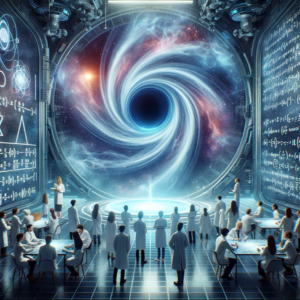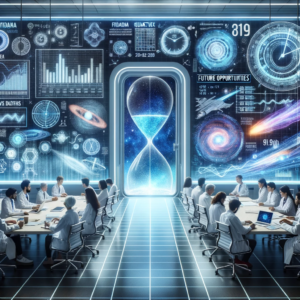Imagine if you could travel back in time and witness historical events, meet influential figures, or even change the course of history. The concept of time travel has fascinated humans for centuries, sparking countless debates and fueling the imaginations of scientists, writers, and dreamers alike. In this article, we will explore what science has to say about the possibility of time travel. We will delve into the theories, examine the scientific principles behind them, and consider the implications that time travel could have on our understanding of the universe. Get ready to embark on a mind-bending journey through the mysteries of time!

Understanding Time Travel
Time travel has always been a fascinating concept that captures the imagination of people across the globe. The idea of traveling to different points in time, witnessing historical events, or even altering the course of history is undeniably enticing. But how feasible is time travel? In this article, we will delve into the concept of time travel, its origin, and its portrayal in popular culture. Let’s embark on this exciting journey together!
Concept of Time Travel
Time travel refers to the hypothetical ability to move backward or forward in time, beyond the certain “flow” that we experience in our everyday lives. It involves traversing through different points in the past, present, or future, defying the conventional linear progression of time. While time travel remains largely within the realm of science fiction, scientists and physicists have explored the possibilities and implications of such a phenomenon.
Origin of the Idea
The idea of time travel has roots that date back centuries. In ancient mythology, stories of gods or mythical beings traversing through time were prevalent. However, it was not until the emergence of modern science and literature that the concept of time travel became more defined. One of the earliest written works portraying time travel was H.G. Wells’ famous novel, “The Time Machine” published in 1895. This iconic novel laid the foundation for a rich and diverse exploration of time travel in popular culture.
Time Travel in Popular Culture
Time travel has become a staple in popular culture, featuring in numerous books, movies, and television shows. From classics like “Back to the Future” to the thought-provoking series “Doctor Who,” the concept of time travel has captured the hearts and minds of audiences worldwide. These portrayals often incorporate various theories and concepts from physics, adding an element of scientific plausibility to an otherwise fantastical idea. The presence of time travel in popular culture serves as a testament to its enduring allure and the fascination it holds for people of all ages.
The Physics of Time Travel
To understand the possibilities and limitations of time travel, we must delve into the realm of physics. The fundamental principles of the theory of relativity, the space-time continuum, and the role of gravity all play crucial roles in shaping our understanding of time travel.
The Theory of Relativity
Albert Einstein’s theory of relativity is at the heart of modern physics. It comprises two essential components: special relativity and general relativity. According to special relativity, time is not absolute but rather relative to the observer’s motion. This theory predicts phenomena such as time dilation, where time runs slower for objects moving at high speeds relative to a stationary observer.
Space-Time Continuum
The space-time continuum is a conceptual framework that combines the three dimensions of space with the dimension of time. It provides a unified understanding of how objects move and interact in the fabric of the universe. According to this framework, massive objects, such as planets or stars, create distortions in the space-time fabric, leading to the phenomenon of gravity.
The Role of Gravity
Gravity, as described by Einstein’s general theory of relativity, has a significant influence on the possibility of time travel. The theory proposes that massive objects bend the fabric of space-time, creating curves that affect the path of objects within their vicinity. These curves provide a potential pathway for time travel, as an object moving along such a curve could encounter a different point in time.
Einstein’s Contribution to Time Travel
Introduction to Einstein’s Theories
Albert Einstein’s groundbreaking theories introduced revolutionary concepts that laid the foundation for our understanding of time travel. His theories of relativity, both special and general, challenged the conventional notions of time and space, opening up possibilities that were previously unimaginable.
Special Relativity and Time Dilation
One of the key concepts explored in special relativity is time dilation. As an object’s speed approaches the speed of light, time slows down relative to a stationary observer. This phenomenon implies that time can be experienced differently depending on the relative motion of the observer and the object in question. While this time dilation effect has been experimentally confirmed, its practical implications for time travel are still a subject of debate.
General Relativity and Gravitational Time Dilation
General relativity delves deeper into the relationship between gravity and time. According to this theory, the presence of a massive object, such as a black hole, can cause an extreme curvature of space-time. This curvature can result in gravitational time dilation, where time runs slower in the presence of stronger gravitational forces. This notion opens up the possibility of accessing different points in time by traversing through regions of intense gravity.
Theoretical Possibility of Time Travel
Understanding Wormholes
Wormholes, also known as Einstein-Rosen bridges, are hypothetical tunnels in space-time connecting two distant points. These theoretical constructs provide a potential shortcut for time travel, where traversing through a wormhole could enable a person to emerge at a different point in space or time. However, the actual existence of wormholes and their stability remains a subject of intense scientific speculation and further exploration.
Concept of Closed Time-like Curves
Closed time-like curves (CTCs) are theoretical paths in space-time that allow for closed trajectories, effectively enabling time travel. These paths often arise from solutions within the framework of general relativity and raise intriguing questions about causality and the possibility of changing the past. The feasibility and consequences of CTCs are actively debated within the scientific community.
Quantum Mechanics and Time Travel
Quantum mechanics, the branch of physics that deals with the behavior of matter and energy at a microscopic level, offers potential insights into the nature of time travel. Quantum effects such as quantum entanglement, quantum superposition, and quantum tunnelling suggest that particles can exist in multiple states or be linked across vast distances, challenging our conventional understanding of time and causality. Harnessing these quantum phenomena may hold the key to unlocking the true potential of time travel.

Time Travel Paradoxes
Grandfather Paradox
The grandfather paradox is one of the most well-known time travel paradoxes. It raises the question of what would happen if you were to travel back in time and encounter a situation that would prevent your own existence. For example, if you were to kill your grandfather before he had children, you would never be born, leading to a contradiction. This paradox highlights the complexities and potential contradictions that arise when considering the ability to change the past.
Bootstrap Paradox
The bootstrap paradox is another intriguing time travel paradox. It occurs when an object or information is said to have no origin, as they are caught in a perpetual loop of being created and sent back in time. In this paradox, an object or information is passed down from the future to the past, where it then becomes the very thing that was initially received. The bootstrap paradox challenges our notions of cause and effect and blurs the boundaries between past and future.
Predestination Paradox
The predestination paradox occurs when an event or action is seemingly predetermined and cannot be altered, despite attempts to change it. In this paradox, an individual’s actions in the past may be seen as leading to their present or future self, creating a deterministic loop where the attempt to change the outcome ultimately becomes the catalyst for the outcome itself. This paradox raises profound questions about free will, fate, and the nature of causality.
Experiments and Observations Supporting Time Dilation
Time Dilation in GPS Satellites
One of the practical applications of the theory of relativity is evident in the functioning of GPS satellites. These satellites are equipped with atomic clocks, which are highly precise timekeeping devices. Due to the high orbital speeds and the influence of gravity, the clocks on these satellites experience time dilation effects. Without accounting for these effects, GPS navigation would quickly become inaccurate. The successful implementation of time dilation correction in GPS technology serves as experimental evidence supporting the validity of Einstein’s theories.
Hafele-Keating Experiment
In 1971, Joseph C. Hafele and Richard E. Keating conducted a groundbreaking experiment that provided empirical evidence for time dilation. They synchronized atomic clocks and sent them on commercial aircraft, flying eastward and westward around the Earth. Upon their return, it was observed that the clocks on the aircraft had experienced slight time discrepancies compared to the reference clocks on the ground. This experiment demonstrated that time dilation occurs due to the motion of the clocks relative to the observer.
Time Dilation in Particle Physics Experiments
Particle physicists regularly observe time dilation effects in their experiments. These experiments involve particles moving at close to the speed of light, where time dilation becomes significant. The observed differences in the decay rates and lifetimes of these accelerated particles compared to their stationary counterparts serve as further evidence for the effects of time dilation predicted by the theory of relativity.

Black Holes and Time Travel
Understanding Black Holes
black holes are astrophysical phenomena that exert incredible gravitational forces. These celestial objects are formed when massive stars collapse under their own gravity, creating an extraordinarily dense region where gravity becomes extremely intense. The concept of black holes has captured the imagination of scientists and science fiction enthusiasts alike, with their unique properties providing a potential pathway for time travel.
Hawking’s Theory on Black Holes
Renowned physicist Stephen Hawking contributed significantly to our understanding of black holes. Hawking’s groundbreaking work on black hole radiation, known as Hawking radiation, proposed that black holes emit particles and gradually lose mass over time. This theory challenged the conventional notion that nothing can escape the gravitational pull of a black hole, and it opened up new possibilities for studying the nature of black holes and their potential implications for time travel.
Black Holes as Time Machines
Black holes have been theorized to function as potential time machines due to their immense gravitational effects. The extreme curvature of space-time around black holes creates the possibility of traversable wormholes or the formation of closed time-like curves, allowing for potential journeys to different points in time. However, the immense challenges and complexities involved in harnessing black holes for time travel render it a purely theoretical concept, at least for now.
Time Travel in Quantum Physics
Quantum Entanglement
Quantum entanglement is a phenomenon in which two or more particles become intertwined in such a way that their properties are inextricably linked, regardless of the spatial distance between them. This peculiar behavior challenges our conventional notions of causality, as actions performed on one entangled particle instantaneously affect the other, regardless of the distance separating them. The implications of quantum entanglement for time travel are still a topic of ongoing research and speculation.
Quantum Superposition
Quantum superposition refers to the concept that particles can exist in multiple states simultaneously until they are measured or observed. Superposition allows particles to occupy multiple points in space-time simultaneously, potentially opening up the possibility of experiencing different points in time simultaneously as well. This phenomenon adds another layer of complexity to our understanding of time travel within the framework of quantum mechanics.
Quantum Tunnelling
Quantum tunnelling is a phenomenon in which particles can “tunnel” through energy barriers that, according to classical physics, they should not be able to overcome. This behavior challenges our intuitive understanding of classical physics and provides potential avenues for exploring the manipulation of space-time. While the direct implications of quantum tunnelling for time travel are still speculative, its fundamental principles contribute to the ongoing pursuit of understanding and harnessing the possibilities of time travel.

Potential Implications of Time Travel
Impact on History and Future
The possibility of time travel raises profound questions about the impact it could have on history and the future. If time travel were to become a reality, would people be tempted to alter past events, leading to unforeseen consequences and potential paradoxes? How would this affect the course of history as we know it? Moreover, the ability to travel to the future could influence our actions and decisions in the present, raising ethical and philosophical dilemmas about the nature of free will and determining our own destinies.
Ethical Implications
Time travel also raises significant ethical considerations. If someone were to go back in time, would they have an obligation to prevent major disasters or tragedies? Is it morally permissible to alter the past for the sake of averting suffering or improving the lives of many at the expense of potentially negating the experiences and choices of others? These ethical dilemmas highlight the complex interplay between time travel, individual autonomy, and the moral responsibility that may come with the ability to alter the course of events.
Influence on Society and Culture
The mere possibility of time travel has already had a profound influence on society and culture. Books, movies, and television shows exploring various time travel scenarios have become a staple of entertainment and have sparked endless discussions and debates. Time travel serves as a powerful narrative tool, allowing us to explore the human experience, contemplate our place in the universe, and ponder the consequences of our actions. The cultural impact of time travel is likely to continue to shape our collective imagination and provoke thought-provoking discussions in the years to come.
Current Research and Future Opportunities in Time Travel
Advancements in Physics and Technology
Advancements in physics and technology continue to push the boundaries of our understanding of time travel. Researchers are exploring new possibilities through experiments involving high-energy particle colliders, quantum physics, and the study of black holes. Innovations in technology, such as the development of more powerful computers and sophisticated simulations, are also providing new avenues for modeling and understanding the complex dynamics of time travel.
Theoretical Models and Simulations
Theoretical models and simulations play a crucial role in advancing our understanding of time travel. Scientists use mathematical models and computer simulations to explore the intricacies of space-time, simulate the behavior of particles, and predict the potential outcomes of time travel scenarios. These simulations allow scientists to investigate the feasibility and implications of different theories and provide insights that guide future research and experimental endeavors.
Hopes for Future Experiments
Scientists and researchers around the world eagerly anticipate future experiments that could shed further light on the possibilities of time travel. Whether it be the construction of more powerful particle colliders, the detection of gravitational waves from distant black holes, or the exploration of quantum phenomena, each step forward brings us closer to unraveling the mysteries of time. With ongoing advancements, we may one day unlock the secrets of time travel and turn this captivating concept into a tangible reality.
In conclusion, time travel remains a captivating and thought-provoking concept that has enthralled people for centuries. While the actual realization of time travel may still lie far beyond our current scientific capabilities, exploring the theoretical underpinnings, conducting elaborate experiments, and pushing the boundaries of our understanding bring us closer to uncovering the true nature of time itself. Until then, we can indulge in the captivating portrayals of time travel in popular culture and continue to ponder the infinite possibilities that time travel may hold for the future of humanity.











